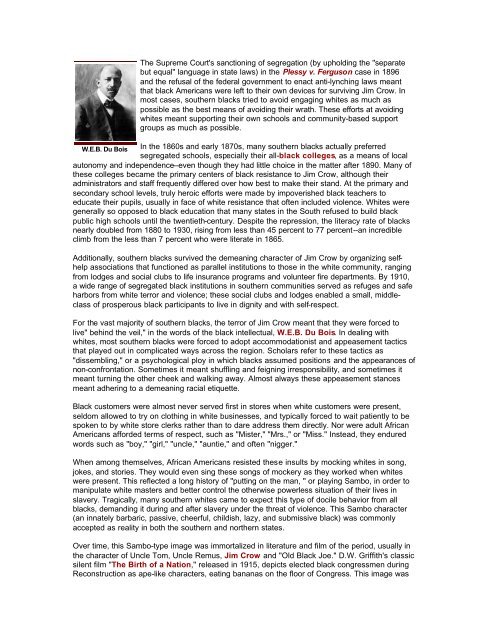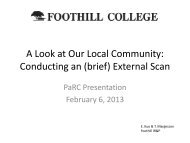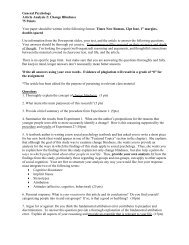From Terror to Triumph: Historical Overview - Foothill College
From Terror to Triumph: Historical Overview - Foothill College
From Terror to Triumph: Historical Overview - Foothill College
Create successful ePaper yourself
Turn your PDF publications into a flip-book with our unique Google optimized e-Paper software.
The Supreme Court's sanctioning of segregation (by upholding the "separate<br />
but equal" language in state laws) in the Plessy v. Ferguson case in 1896<br />
and the refusal of the federal government <strong>to</strong> enact anti-lynching laws meant<br />
that black Americans were left <strong>to</strong> their own devices for surviving Jim Crow. In<br />
most cases, southern blacks tried <strong>to</strong> avoid engaging whites as much as<br />
possible as the best means of avoiding their wrath. These efforts at avoiding<br />
whites meant supporting their own schools and community-based support<br />
groups as much as possible.<br />
W.E.B. Du Bois In the 1860s and early 1870s, many southern blacks actually preferred<br />
segregated schools, especially their all-black colleges, as a means of local<br />
au<strong>to</strong>nomy and independence--even though they had little choice in the matter after 1890. Many of<br />
these colleges became the primary centers of black resistance <strong>to</strong> Jim Crow, although their<br />
administra<strong>to</strong>rs and staff frequently differed over how best <strong>to</strong> make their stand. At the primary and<br />
secondary school levels, truly heroic efforts were made by impoverished black teachers <strong>to</strong><br />
educate their pupils, usually in face of white resistance that often included violence. Whites were<br />
generally so opposed <strong>to</strong> black education that many states in the South refused <strong>to</strong> build black<br />
public high schools until the twentieth-century. Despite the repression, the literacy rate of blacks<br />
nearly doubled from 1880 <strong>to</strong> 1930, rising from less than 45 percent <strong>to</strong> 77 percent--an incredible<br />
climb from the less than 7 percent who were literate in 1865.<br />
Additionally, southern blacks survived the demeaning character of Jim Crow by organizing selfhelp<br />
associations that functioned as parallel institutions <strong>to</strong> those in the white community, ranging<br />
from lodges and social clubs <strong>to</strong> life insurance programs and volunteer fire departments. By 1910,<br />
a wide range of segregated black institutions in southern communities served as refuges and safe<br />
harbors from white terror and violence; these social clubs and lodges enabled a small, middleclass<br />
of prosperous black participants <strong>to</strong> live in dignity and with self-respect.<br />
For the vast majority of southern blacks, the terror of Jim Crow meant that they were forced <strong>to</strong><br />
live" behind the veil," in the words of the black intellectual, W.E.B. Du Bois. In dealing with<br />
whites, most southern blacks were forced <strong>to</strong> adopt accommodationist and appeasement tactics<br />
that played out in complicated ways across the region. Scholars refer <strong>to</strong> these tactics as<br />
"dissembling," or a psychological ploy in which blacks assumed positions and the appearances of<br />
non-confrontation. Sometimes it meant shuffling and feigning irresponsibility, and sometimes it<br />
meant turning the other cheek and walking away. Almost always these appeasement stances<br />
meant adhering <strong>to</strong> a demeaning racial etiquette.<br />
Black cus<strong>to</strong>mers were almost never served first in s<strong>to</strong>res when white cus<strong>to</strong>mers were present,<br />
seldom allowed <strong>to</strong> try on clothing in white businesses, and typically forced <strong>to</strong> wait patiently <strong>to</strong> be<br />
spoken <strong>to</strong> by white s<strong>to</strong>re clerks rather than <strong>to</strong> dare address them directly. Nor were adult African<br />
Americans afforded terms of respect, such as "Mister," "Mrs.," or "Miss." Instead, they endured<br />
words such as "boy," "girl," "uncle," "auntie," and often "nigger."<br />
When among themselves, African Americans resisted these insults by mocking whites in song,<br />
jokes, and s<strong>to</strong>ries. They would even sing these songs of mockery as they worked when whites<br />
were present. This reflected a long his<strong>to</strong>ry of "putting on the man, " or playing Sambo, in order <strong>to</strong><br />
manipulate white masters and better control the otherwise powerless situation of their lives in<br />
slavery. Tragically, many southern whites came <strong>to</strong> expect this type of docile behavior from all<br />
blacks, demanding it during and after slavery under the threat of violence. This Sambo character<br />
(an innately barbaric, passive, cheerful, childish, lazy, and submissive black) was commonly<br />
accepted as reality in both the southern and northern states.<br />
Over time, this Sambo-type image was immortalized in literature and film of the period, usually in<br />
the character of Uncle Tom, Uncle Remus, Jim Crow and "Old Black Joe." D.W. Griffith's classic<br />
silent film "The Birth of a Nation," released in 1915, depicts elected black congressmen during<br />
Reconstruction as ape-like characters, eating bananas on the floor of Congress. This image was
















